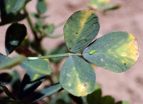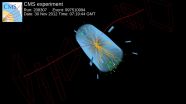(Press-News.org) The potato leafhopper is a tiny insect--barely half the size of a grain of rice--with a bright lime green color that helps it blend in against plant leaves. Despite its unassuming appearance, this little pest causes big headaches for farmers across the eastern half of the United States. By feeding voraciously on many crops, including potatoes, green beans and alfalfa, the migratory potato leafhopper causes untold millions of dollars in damage every year.
Now, a study by entomologists at the University of Maryland and Queens College at the City University of New York suggests that climate warming could be making this problem worse. Using data that span more than six decades, the team found that potato leafhoppers arrive an average of 10 days earlier than in the early 1950s, and their infestations are more severe in the warmest years. These effects correspond to an overall increase in years with warmer than average temperatures over the same time period. The results were published online May 13, 2015 in the journal PLOS ONE.
"The potato leafhopper is a significant pest in this country, spanning multiple crops across a large area. The scale of influence is huge," said Dilip Venugopal, a research associate in entomology at UMD and co-lead author of the study. "Our results indicate that agricultural systems need to prepare for the effects of climate change on migratory pests. Earlier arrival is just one of the many factors that we need to be ready for."
Potato leafhoppers attack a wide variety of plant species, not just their namesake potato plants. They have a particular taste for alfalfa, which is an important forage crop for livestock. In Vermont, they have been known to go after hop plants, causing trouble for that state's famed craft beer industry. They even feed on non-agricultural plants, such as red maple trees. All told, they cause damage to more than 200 plant species throughout their considerably large range.
The insect's feeding strategy is subtle enough to avoid detection at first. By piercing a plant's leaves and stems with their mouthparts, leafhoppers feed on the sap and other liquids within. Leafhopper saliva also contains a toxin that can cause drying, curling and rotting of plant tissues, resulting in a characteristic syndrome known as "hopperburn."
"Earlier arrival dates make it particularly important for farmers to get out early in the season and scout for leafhoppers," said William Lamp, an associate professor of entomology at UMD and a co-author of the study. "They're tiny, flighty and very hard to see. You don't realize they're even there until you see the damage to the plants, which can take up to a week to manifest. By then it's too late."
The study integrated data on leafhopper arrival dates and infestation severity from a variety of sources, including reports from state-level agricultural extension programs and published scientific studies. The researchers compared these data with temperature data from the National Oceanic and Atmospheric Administration's National Climatic Data Center. In addition to earlier arrival dates, the leafhopper data also show that years with warmer than average temperatures also had the most severe infestations.
"The historical records on agricultural pests are a gold mine, made possible by decades of hard work by agricultural research and extension personnel who collect this data," Venugopal said. "There has been a decline in data collection activity over the past decade, and we would love to see an effort to ramp this up again."
The researchers note that the potato leafhopper is only one of many migratory pest species that are likely to change their migration and feeding habits in response to climate warming.
"Climate change is not just costly because temperatures and oceans rise, but because it makes it harder to feed ourselves," said Mitchell Baker, an associate professor of biology at Queens College at the City University of New York and co-lead author of the paper. "Increased pest pressure in agriculture is one of the complex effects of continued warming. Predicting arrival time and severity is critical to managing this pest and others like it."
INFORMATION:
This research was supported by the U.S. Department of Agriculture (Award No. #MD-ENTM-1016), the Professional Staff Congress-City University of New York (Award No. 43-65677) and the UMD Library Open Access Publishing Fund. The content of this article does not necessarily reflect the views of these organizations.
The research paper, "Climate change and phenology: Empoasca fabae (Hemiptera: Cicadellidae) migration and severity of impact," Mitchell Baker, Dilip Venugopal and William Lamp, was published online May 13, 2015, in the journal PLOS ONE.
Media Relations Contact: Matthew Wright, 301-405-9267, mewright@umd.edu
University of Maryland
College of Computer, Mathematical, and Natural Sciences
2300 Symons Hall
College Park, MD 20742
http://www.cmns.umd.edu
@UMDscience
About the College of Computer, Mathematical, and Natural Sciences
The College of Computer, Mathematical, and Natural Sciences at the University of Maryland educates more than 7,000 future scientific leaders in its undergraduate and graduate programs each year. The college's 10 departments and more than a dozen interdisciplinary research centers foster scientific discovery with annual sponsored research funding exceeding $150 million.
Alcohol drunk by a mouse in early pregnancy changes the way genes function in the brains of the offspring, shows the recent study conducted at the University of Helsinki. The early exposure was also later apparent in the brain structure of the adult offspring. The timing of the exposure corresponds to the human gestational weeks 3-6 in terms of fetal development.
In addition, the exposure to alcohol was found to cause similar changes to gene function in other tissues of the infant mice. These results suggest that alcohol causes permanent changes to gene regulation in ...
Two experiments at the Large Hadron Collider at the European Organization for Nuclear Research (CERN) in Geneva, Switzerland, have combined their results and observed a previously unseen subatomic process.
As published in the journal Nature this week, a joint analysis by the CMS and LHCb collaborations has established a new and extremely rare decay of the Bs particle (a heavy composite particle consisting of a bottom antiquark and a strange quark) into two muons. Theorists had predicted that this decay would only occur about four times out of a billion, and that is roughly ...
Benign prostatic hyperplasia (BPH) -- or, simply, prostate enlargement -- is one of the most common diseases of aging among men in the United States. In fact, by the time they hit 80 or above, upwards of 90 percent of all men in the U.S. experience some degree of prostate enlargement. And of those, 40 percent require medical treatment.
Despite the fact that the disease impacts so many people and carries with it a huge price tag -- estimated at tens of billions of dollars per year in medical expenses and lost wages, among other costs -- the factors that contribute to BPH ...
For the first time, satellite mapping of Latin America shows that the continent's agricultural expansion has waned in the wake of the global economic downturn, according to UBC research.
"Nearly every agricultural region across Latin America slowed down in expansion from 2007 to 2013, compared to the previous six years," says Jordan Graesser, the study's lead author. Graesser is a visiting international student at UBC's Liu Institute for Global Issues and the Institute for Resources, Environment and Sustainability.
The study, recently published in Environmental Research ...
ITHACA, N.Y. -- If you're planning to fly over the holiday, plan to drink some tomato juice. While examining how airplane noise affects the palate, Cornell University food scientists found sweetness suppressed and a tasty, tender tomato surprise: umami.
A Japanese scientific term, umami describes the sweet, savory taste of amino acids such as glutamate in foods like tomato juice, and according to the new study, in noisy situations -- like the 85 decibels aboard a jetliner -- umami-rich foods become your taste bud's best buds.
"Our study confirmed that in an environment ...
PITTSBURGH -- A research team led by the University of Pittsburgh's Jeremy Levy has discovered electrons that can "swing dance." This unique electronic behavior can potentially lead to new families of quantum devices.
Superconductors, materials that permit electrical current to flow without energy loss, form the basis for magnetic resonance imaging devices as well as emerging technologies such as quantum computers. At the heart of all superconductors is the bunching of electrons into pairs.
Levy, Distinguished Professor of Physics and Pittsburgh Quantum Institute director, ...
The type of perfectionist who sets impossibly high standards for others has a bit of a dark side. They tend to be narcissistic, antisocial and to have an aggressive sense of humor. They care little about social norms and do not readily fit into the bigger social picture. So says Joachim Stoeber of the University of Kent in the UK, who compared the characteristics of so-called other-orientated perfectionists against those of perfectionists who set the bar extremely high for themselves. The study is published in Springer's Journal of Psychopathology and Behavioral Assessment.
Perfectionism ...
Typhoon Dolphin (strengthened overnight on 5/12 from Tropical Storm status) formed south of Pohnpei in the western Pacific Ocean on May 7, 2015. Dolphin's power has oscillated from a weak tropical depression to typhoon intensity over the past five days. Dolphin is now an intensifying typhoon headed westward.
The GPM core observatory satellite flew over Dolphin on May 12, 2015 at 2301 UTC. At that time Dolphin's wind speeds were estimated at about 65 kts (75 mph). Rainfall collected by GPM's Microwave Imager (GMI) showed that rain was falling at a rate of over 47 mm (1.9 ...
As murder mysteries go, it's a big one: how do galaxies die and what kills them? A new study, published today in the journal Nature, has found that the primary cause of galactic death is strangulation, which occurs after galaxies are cut off from the raw materials needed to make new stars.
Researchers from the University of Cambridge and the Royal Observatory Edinburgh have found that levels of metals contained in dead galaxies provide key 'fingerprints', making it possible to determine the cause of death.
There are two types of galaxies in the Universe: roughly half ...
If you walk into a dark room, you can still find your way to the light switch. That's because your brain keeps track of landmarks and the direction in which you are moving. Fruit flies also boast an internal compass that works when the lights go out, scientists at the Howard Hughes Medical Institute's Janelia Research Campus have discovered. Their findings suggest that dissecting how fruit flies navigate through the world could help researchers understand how humans and other mammals achieve that task.
In our brains, several kinds of neurons help us get and keep our bearings. ...




